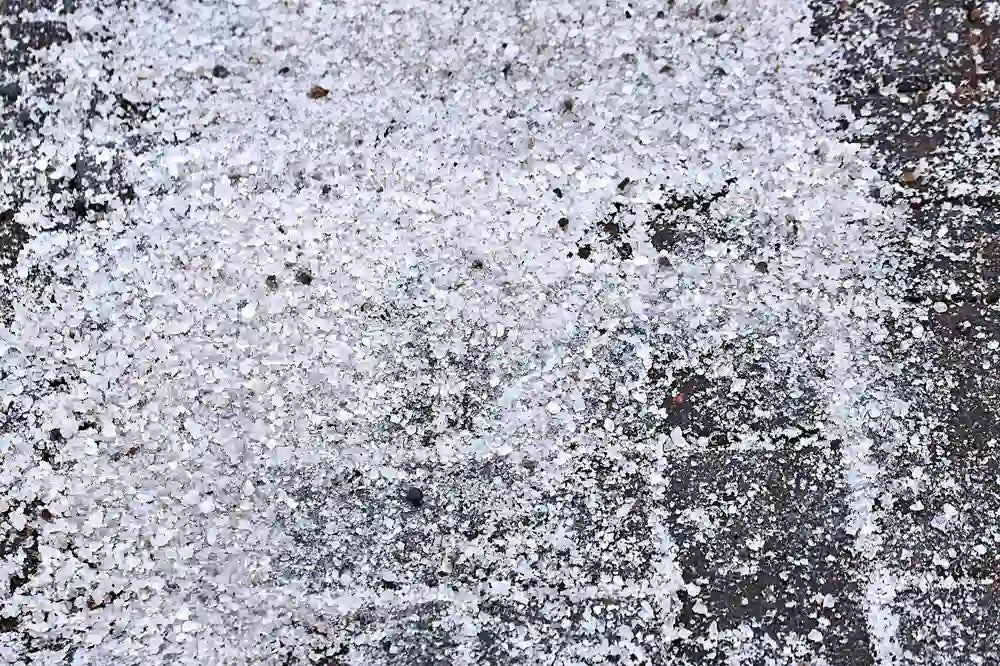
How to Break Up Hardened Rock Salt: Top 7 Tips
Winter is prime time for ice-melting products like bulk road salt. Rock salt is a common de-icer for melting snow and ice on roads, parking lots, and driveways. But if salt gets exposed to moisture and compresses in storage, it can transform from free-flowing crystals into rock-hard clumps. As you can imagine, trying to spread hardened rock salt on icy parking lots and driveways can be frustrating and time-consuming. Large chunks can cement together and resist coming apart.
Before winter arrives, it’s important to know how to deal with clumped de-icer salt. In this blog post, our team at Ninja De-Icer will explore the top 7 tips and tricks for breaking up hardened rock salt quickly and efficiently. With a few simple tools and techniques, you can break up frustrating salt chunks and get your salt ready to tackle snow and ice accumulation.
What Is Road Salt?

Road salt, also known as rock salt, is a type of deicer used to remove ice and snow from roads and surfaces. Made of sodium chloride, road salt is spread on icy surfaces to lower the freezing point of water and accelerate the melting process. It helps improve traction and ensures safer driving conditions during winter.
What Causes Road Salt Hardening?
Road salt has a tendency to clump together due to a couple of factors. One of the main reasons is moisture. When road salt is exposed to humidity or moisture from the air or melting ice, it can absorb the water which causes the salt particles to stick together and form clumps. Another factor is temperature fluctuations. When salt is repeatedly exposed to freezing and thawing cycles, the moisture trapped within the salt can expand and contract, leading to clumping. Because road salt is a hygroscopic solid that attracts water and heat from the environment, it's highly susceptible to freezing and clumping together.
Ensure a steady supply for winter maintenance with our high-quality bulk rock salt. Keep roads and parking lots safe with Ninja De-Icer!
Bulk Rock Salt Supply by Ninja De-Icer
How to Break Up Frozen Bulk Salt
Just because your rock salt has hardened doesn't mean you have to throw it away.
Here's how to break up salt chunks:
1. Drop the Clumped Rock Salt (for Bagged Products Only)
When rock salt hardens and clumps together, the best way to deal with it is to drop the bag. Dropping the clumped rock salt onto a hard surface, such as pavement or concrete, creates an impact that can help break apart the hardened salt. Repeat this process a few times as needed. You can apply force when dropping the bag until the clumps start to loosen. But be careful when doing this, you'll want to avoid injury or damage to the surrounding area in the process.
2. Let It Thaw Out
If road salt has hardened and clumped together, placing it in a warm environment can help soften it. Find a warm place, such as a heated space or a sunny spot, and spread out the clumped salt. The heat will gradually melt the moisture within the salt and make it easier to break apart. Or just wait for the temperature to get warmer before using it again. This simple method can be effective in restoring the salt to a usable state.
3. Break Salt Up with a Skid Steer or Loader

When dealing with large salt clumps, using a skid steer or loader can be an efficient way to break it up. These heavy-duty machines are equipped with buckets or attachments that can easily scoop up and break apart the hardened road salt. They have powerful hydraulic systems that can apply significant force to crush the clumps, making it easier to spread and melt the salt. This method is particularly useful for large areas or heavy accumulations of hardened salt. It allows for quick and effective removal during winter maintenance operations.
4. Use a Hammer or Power Drill to Break Salt Apart
When road salt has hardened, using a hammer or power drill can be effective in breaking it apart. Place the softened salt on a hard surface and carefully strike it with a hammer as many times as needed to break it into smaller pieces. You can also attach a drill bit to a power drill and use it to drill into the clumps of salt, gradually breaking them apart. This method is better for smaller quantities of clumped salt. If you choose this method, remember to wear protective gear and exercise caution when using tools.
5. Use a Shovel or Ice Pick
During the winter season, when salt has hardened, a simple and effective method to break it up is to use a shovel or ice pick. Start by loosening the surface layer of the salt with the edge of the shovel or the pointed end of the ice pick. Then, apply controlled force to break the hardened salt into smaller pieces. Again this method is going to be better for smaller quantities of clumped salt. This technique allows for easier removal and spreading of the salt and results in safer conditions on roads and walkways.
6. Try Liquid De-Icer to Soften Salt

When faced with stubborn salt clumps, using a liquid de-icer can be an effective solution. Liquid de-icers, such as calcium chloride or magnesium chloride, can be applied directly to the hardened road salt. These de-icers work by penetrating the salt, melting it from the inside out, and breaking up the clumps. Apply the liquid de-icer evenly over the salt and give it time to penetrate and soften the hardened areas. This method is especially useful if you have large quantities of hardened salt. As a bonus, you’ll now have treated bulk salt you can use on your properties.
7. Mix Sand with the Hardened Salt
By combining sand with the hardened salt, you add abrasiveness that helps to break up the clumps and improve traction. Spread a layer of sand over the hardened salt and use a skid steer to work the mixture, breaking it apart and making it easier to handle. This method is a practical solution for melting ice and maintaining safe conditions during winter.
Say goodbye to ice and snow with our powerful liquid de-icers. Designed to effectively melt ice and prevent clumping, our product ensures safer conditions!
Liquid De-Icer Solution by Ninja De-Icer
Keeping Rock Salt from Clumping: The Bottom Line
Breaking up hardened rock salt doesn't have to be a daunting task. By following these top 7 tips, including using a skid steer or loader to break it up or applying liquid de-icer to it, you can effectively break apart hardened salt and make it easier to spread and melt. Before jumping into the method of your choice, remember to take precautions when working with tools and wear protective gear.
If you're looking for a reliable de-icing solution, consider Ninja De-Icer, a nationwide supplier of ice melt products. Get a quote on premium ice melt products delivered when and where you need them this winter. With the right product and supplier, you’ll be ready to take on ice and snow.
FAQs
How to stop salt from clumping?
The easiest way to prevent salt from clumping when temperatures drop is to store it in a dry covered place. Sometimes winter can surprise you, and you won't need to use all your rock salt in one season, so you'll need to know how to store salt.
To prevent salt from clumping when temperatures drop, we recommend avoiding exposure to moisture, which is the primary cause of clumping. To store salt products properly, keep them covered in a shed or warehouse, or cover them with a tarp outside to protect them. Storing salt indoors in a dry environment is the ideal way to preserve the quality of the product for use in future years.
How do you dry out road salt?
To dry out road salt, it's best to spread it out in a well-ventilated area with good airflow. Allow the salt to sit and air dry naturally, avoiding any contact with moisture. You can also use a dehumidifier or fan to expedite the drying process. Regardless of the method you choose, it's important to make sure the salt is completely dry before storing it to prevent clumping.
What to do with old ice melt products?
Most ice melt products contain chloride, which doesn't really go bad. However, sodium chloride products will lose their potency if they aren't stored properly. If you need to dispose of ice melt, don't pour it down a storm drain or dump it on the lawn as it may cause environmental damage. As an alternative, you can give away, sell, or donate unwanted sodium chloride.
Better yet, just keep it for next winter or use it for dust control in the summer months. Remember, ice melt will naturally attract moisture from the air keeping roads and open surfaces damp, even under hot and dry conditions.



